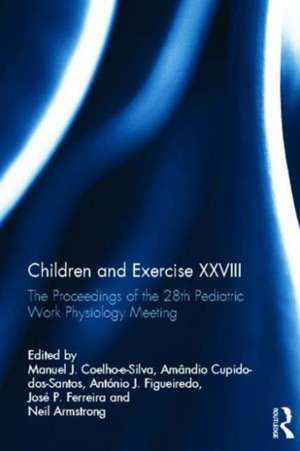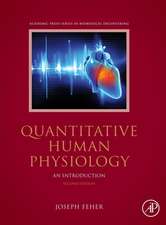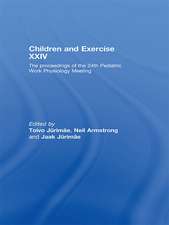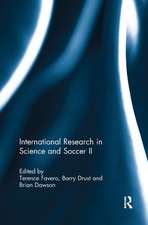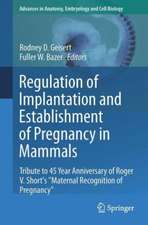Children and Exercise XXVIII: The Proceedings of the 28th Pediatric Work Physiology Meeting
Editat de Manuel Coelho-E-Silva, Amândio Cupido-dos-Santos, António J. Figueiredo, José P. Ferreira, Neil Armstrongen Limba Engleză Hardback – 26 sep 2013
- Cardiovascular responses to exercise
- Genetics, metabolism and physical activity
- Limiting factors of muscle exercise
- Respiratory responses to exercise
- Epidemiology in physical activity and obesity
- Physical activity and nutrition
- Metabolic disorders and exercise
Preț: 850.59 lei
Preț vechi: 1179.80 lei
-28% Nou
Puncte Express: 1276
Preț estimativ în valută:
162.76€ • 170.39$ • 134.67£
162.76€ • 170.39$ • 134.67£
Carte tipărită la comandă
Livrare economică 05-19 aprilie
Preluare comenzi: 021 569.72.76
Specificații
ISBN-13: 9780415829724
ISBN-10: 0415829720
Pagini: 322
Ilustrații: 70 tables
Dimensiuni: 156 x 234 x 23 mm
Greutate: 0.61 kg
Ediția:New.
Editura: Taylor & Francis
Colecția Routledge
Locul publicării:Oxford, United Kingdom
ISBN-10: 0415829720
Pagini: 322
Ilustrații: 70 tables
Dimensiuni: 156 x 234 x 23 mm
Greutate: 0.61 kg
Ediția:New.
Editura: Taylor & Francis
Colecția Routledge
Locul publicării:Oxford, United Kingdom
Public țintă
PostgraduateCuprins
Part I: Rutenfranz Lecture 1. Youth, sport, and physical activity Part II: Keynote Lectures 2. Physical activity for obese youth: Implications for chronic disease risk factors 3. Child health needs of young children from families living in social and economic disadvantage 4. School based physical activity interventions can work: How effective are they and what does it take to get them implemented? 5. The companionship of sedentary behaviour, physical activity, fitness, and health-findings from the EYHS (European Youth Heart Study) 6. Genetics of physical activity: A brief summary 7. Training and testing elite young athletes Part III: Physiology 8. Moderate exercise, energy intake restriction and postprandial triacylglycerol in healthy girls 9. Training increases anabolic and reduces inflammatory response to a single practice in male volleyball players 10. Thermoregulatory responses of artistic gymnast young athletes and non-athlete girls during exercise in heat 11. Lipid profile and presence of dyslipidaemia in physically active and insufficiently active Brazilian adolescents 12. Bone ultrasound attenuation of children with Down syndrome: Relations with static stabliometric characeteristics Part IV: Neuromuscular 13. Isokinetic strength of lower limbs and its differences depending on gender, muscle group and angular velocity in children 14. Voluntary activation of the adductor pollicis in children: A peripheral magnetic stimulation study 15. Changes of postural stability with regard to gender, age and visual control of children 16. Advancement in the interpretation of isokinetic ratios derived from the hamstring and quadriceps Part V: Cardiovascular and Cardiorespiratory Fitness 17. Allometric scaling of left ventricular mass in relation to body size, fat-free mass and maturation in 13-year-old boys 18. Cardiorespiratory fitness and academic achievement in a large cohort of British children: Does selective attention matter? 19. Somatic maturity and central obesity as independent predictors of cardiorespiratory fitness in adolescents 20. Association between somatic maturity, physical activity and blood pressure in adolescents 21. Modelling developmental changes in left ventricular mass using multiplicative allometric and additive polynomial multilevel modelling in boys aged 11-16 years 22. Criterion-related validity of the 20-m shuttle run test in Brazilian adolescents aged 11-13 years Part VI: Physical Fitness and Health 23. Anthropometric model to estimate body fat in boys using a multicompartmental approach 24. Impact of behaviour determinants on overweight and obesity among Brazilian schoolchildren: Parana Healthy Program 25. Weight/height3.034 is a necessary tool in relative body mass estimation of adolescents 26. Secular trend of nutritional status and cardiorespiratory fitness in children 27. Multivariate association between health-related quality of life and physical fitness in female students Part VII: Physical Activity and Sedentary Behaviour 28. The effects of a 6-week resistance training programme in children with JIA: A pilot study 29. Nature Ninjas: Piloting a nature-based physical activity and youth development intervention in elementary school children 30. The impact of social competence and motor performance on physical activity 31. Association between bone mineral density and physical activity in 12-to-14-year-old underweight boys 32. Objectively assessed physical activity and guideline compliance: The Midlands Adolescent Lifestyle Study 33. Physical activity intensity of the Wii Dance game for children 6-9 years of age 34. Validity of accelerometer regression models to estimate METs in adolescents 35. Effects of a 1-year training programme on the skeleton of Down syndrome children? 36. Agreement of physical activity assessed by objective and selfreported measures: Variation by weight status Part VIII: Sport Participation and the Young Athlete 37. Drop-out in Brazilian youth tennis players: A comparative study 38. Systematized learning assessment in swimming practice 39. Importance of the social environment in the development of field hockey expertise 40. Coaches’ judgment about current and future performance level of basketball players 41. Biological maturation at time of selection and swimming career paths in Flemish swimmers 42. Peak VO2 in prepubertal swimmers 43. Absolute and scaled peak power assessments in young male soccer players: Variation by playing position 44. Training behaviour in relation to performance development in talented speed skaters: A descriptive study 45. The anthropometric characteristics of young paddlers and their relationship with paddle set-up and performance 46. Correlation between critical velocity and maximal lactate steady sate in adolescent swimmers 47. Agreement between peak power outputs obtained from the application of common braking force and the estimated optimal load in soccer goalkeepers 48. Agreement between invasive and non-invasive indicators of biological maturation in adolescent swimmers 49. Reproducibility of repeated dribbling ability 50. Allometric modelling of peak power output obtained from a force-velocity protocol in prepubertal boys Armstrong 51. Is gymnastics exposure associated with skeletal benefits in the forearm in young children? 52. Maturity of children and adolescents belonging to well defined activity groups: Sedentary, leisure, sports
Notă biografică
Manuel J Coelho e Silva is Associate Professor of Auxology and Kinanthropometry in the Faculty of Sport Science and Physical Education at the University of Coimbra, Portugal. He is also Fellow of the European College of Sport Science and member of scientific board of the Institute for Interdisciplinary Investigation at the University of Coimbra.
Neil Armstrong is Professor of Paediatric Physiology and Director of the Children's Health and Exercise Research Centre at the University of Exeter, UK. He is also Vice-President and Senior Deputy Vice-Chancellor of the University of Exeter.
Neil Armstrong is Professor of Paediatric Physiology and Director of the Children's Health and Exercise Research Centre at the University of Exeter, UK. He is also Vice-President and Senior Deputy Vice-Chancellor of the University of Exeter.
Descriere
Children and Exercise XXVIII presents the latest scientific research into paediatric exercise physiology, endocrinology, kinanthropometry, growth and maturation, and youth sport. It includes many contributions from a wide-range of leading international experts. Offering critical reviews of current topics and reports of current and on-going research in paediatric health and exercise science, this is a key text for all researchers, teachers, health professionals and students with an interest in paediatric sport and exercise science, sports medicine and physical education.
